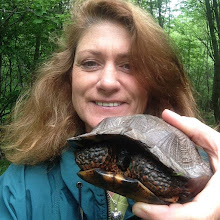
Another chilly dusk walk, up at Cascade Lake Park. It isn't a time of day that I ordinarily take a walk, but I'm really starting to enjoy the blissful silence of the last moments of the day. Dawn, Day, Dusk and Night time each offer unique experiences with different creatures for those of us willing to venture out of our box. Every type of animal has their own niche that they fit and thrive in. If you never get out during those other times you don't experience all that being out in nature has to offer. The forest was silent except for the sound of two Barred Owls calling back and forth and a lone Coyote barking. The owls are courting and soon to be setting on eggs. Their voices calling back and forth are magical, truly something that everyone should experience. I'm really looking forward to taking Petey out for dusk walks on the two days I have to work this week. Petey has discovered his own new joy during our dusk walks...doing zoomies all over the frozen pond! He is also able to just stand and listen to the owls call, I've never had a dog who looks and listens to everything around him. Yes....he is my perfect companion....moms boyfriend may be right...you won't ever get another like him, I pray that I don't have to find that out for another decade.
Barred Owl
Strix varia
Taxonomy:
Class: Aves
Order: Strigiformes
Family: Strigidae
Subfamily: Striginae
Genus: Strix
Length: 16-25 in.
Weight: 1-1.5 lbs. (females slightly larger than males)
Wingspan: 38-50 in.
Common Names: hoot owl, rain owl, round-headed owl, swamp owl, wood owl
Etymology: strix (Latin) - "a strident owl"; varia (Latin) - "variegated"
Description: The barred owl is a large owl with a round head, no ear tufts and a long tail. Primarily gray and brown with white bars and edges, and the face is gray-brown. Barred owl under parts are buff with vertical streaks, the collar is barred horizontally, contrasting with a streaked breast. These owls have dark brown (virtually black) eyes and a yellow or white beak almost covered by feathers.
Flight: Buoyant and light, noiseless with slow, heavy wing beats. Rarely soars, but frequently flies high.
Voice: Loud, very vocal hooting, often in response to each other. "Hoo-hoo-to-hoo-oo, hoo-hoo to wha-aa" suggests " Who cooks for you? Who cooks for you all?" They are extremely vocal in February and March, and again during late summer and fall. Probably the most vocal of all owls.
Habitat: Barred owls prefer mature forests and heavily wooded swamps. They roost in densely forested areas, and hunt over farmland, open country, roadsides and rivers. They are often associated with red-shouldered hawks.
Distribution: The barred owl is found all over the eastern United States, north into Canada and south into Florida and Texas. They are also found in the Pacific Northwest, overlapping with spotted owl habitat.
Nesting: Barred owls are fairly sedentary, a behavior that may contribute to establishing long-term pair bonds and nest territoriality. They frequently use abandoned red-shouldered hawk or crow nests; also large, deep hollows in trees or nest boxes. Barred owls will often nest close to red-shouldered hawks without conflict, and may use the same nest several years in a row. They lay 2-3 (rarely 4-5) white eggs, with a slightly rough texture. Incubation is all done by the female, and lasts approximately 28-33 days. The young owlets begin branching by 4- 5 weeks, but do not fledge until they are closer to 6 weeks old.
Food: Barred owl prey size spans from insects to woodchucks, geese, and herons. They are opportunistic hunters, and will often eat easy to catch prey such as lizards, frogs and small rodents.

No comments:
Post a Comment